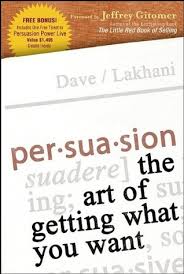Notes on Persuasion and
OpEd

The
Cambridge Dictionary defines "to persuade" as, "to
cause people to do or believe something, esp. by explaining why they
should: ...." In many senses all writing is persuasive, and when
readers finish a piece, it proves the writing was, indeed, successfully
persuasive, at least, in keeping the reader engaged. Most every
decision we make, large or small, involves persuasive elements as we
choose what to do. But maybe the most powerful and subtle persuasion
that we contact everyday is advertising. In many varieties of print, on
radio, TV, and more and more on websites, we are invited, kidded and
intimidated into buying what the seller is selling. Advertising,
whether we admire it or not, has much to teach us about what moves
(persuades) us to act. 
Even in ads or
persuasive discussion, the elements
of a reasoned argument are present, clearly or implied:
basically, statement>reason>evidence.
Persuasion allows for more informal style, but those 3 basics
are there.
LINKS:
Effective
Persuasive Strategies,| More Persuasive
Techniques -Aristotle's
Persuasive Appeals |-
ELEMENTS
FOR PERSUASIVE WRITING
-
Must have a ONE
SENTENCE declarative statement, NOT a question and without using "I" or
pronouns.
-
Must contain
the
TOPIC, the writer's POSITION and for the persuasion essay, the primary
REASON(s).
Op-Ed persuasive writing uses class thesis
guidelines and the models in: | sample OpEd
| Search
return for CURRENT NYT OpEds |
OpEd how-to |
another OpEd how-to.
-
|
Stages FOR A GENERAL
PERSUASIVE ESSAY within a specific assignment:
STAGE 1. CHOOSE
A CURRENT, CONTROVERSIAL TOPIC that you have energy for.
- STAGE 2 DO A TOPIC EXPLORATION
EX. TO:

~ IDENTIFY WHAT YOU ALREADY KNOW
AND
~ IDENTIFY WHY THE TOPIC IS IMPORTANT TO YOU.
~ AND FIND/make THESIS FROM PART 6 [ into ONE SENTENCE... ]
STAGE 3 RESEARCH TO FIND SOURCES
& MAKE A LIST OF ANY THAT ARE POSSIBLE--ANNOTATE KEY ELEMENTS AS
NEEDED.
- STAGE 4 .
COMPLETE a Planning
the Paper Ex. TO
BEGIN MAKING and ordering paragraphs.
- STAGE 5. IDENTIFY WHERE SOURCE INFORMATION WILL BE PLACED
IN THE ESSAY TO BACKUP ANY FACTS
OR
-
BORROWED INFORMATION. CITES can
be live links to the source or to the biographical list.
-
FYI: For this essay/oped AND for the major essa, video documentaries
can show many of the elements we use in
-
documented writing. In both, the narrator/writer introduces main
idea(s), explains, introduces/credits
-
experts/evidence, ties all the ideas together. Video documentary
sites may also include written transcripts.
|
- Specifics for an OpEd essay: can be based on
the stages of Persuasive writing above.
- CHOOSE
A CURRENT, CONTROVERSIAL TOPIC that you have energy for and that might well expand into the
focus for the main essay.
-
Persuasive/OpEdwriting
is 800-900 wds and for this assignment does
include 3-5
sources of factual, verifiable data. Signal
phrases are crucial for crediting sources and should include as part of a sentence: 1) the author and 2) briefly where the source
can be found, and 3) a hyperlink (Word can do this) should be made of
the reference--one
word or more. 
-
If possible
use an analogy, situation or an example to convey what you're trying
communicate.
-
Writing
should be informal--semi-formal, in style and diction, reflect the
energy the writer has for the topic. In fact, Opeds can be even
reasoned, documented "rants."
-
The assumed
reader would be someone with only general knowledge of the topic, and
any "special" words or terms should by briefly explained or defined.
-
The
title can be creative and should
reflect the point directly or ironically.
|



